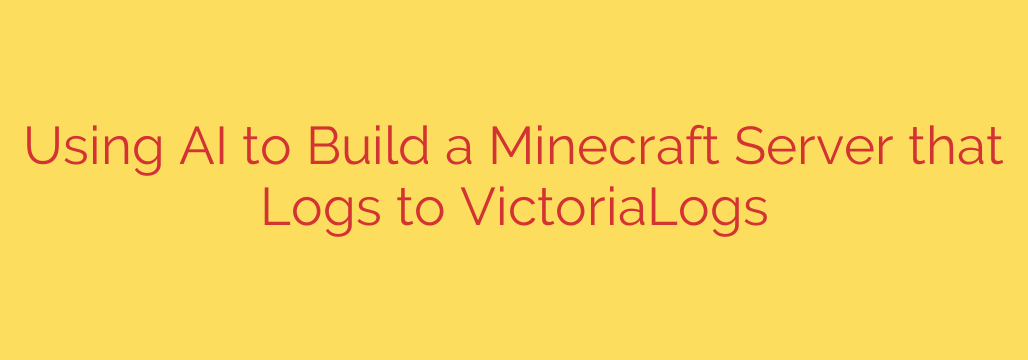
Setting up and managing a Minecraft server can be a rewarding experience, whether for personal use, friends, or a larger community. To ensure smooth operation, diagnose issues, and gain insights into server activity, effective logging and monitoring are crucial. While navigating the technical steps involved might seem daunting, leveraging modern tools, including AI assistance, can simplify the process significantly.
This guide walks through setting up a Minecraft server using Docker, configuring it for comprehensive logging, and integrating those logs with VictoriaLogs, a high-performance, cost-effective time series database and logging solution.
The Power of AI Assistance
Modern AI chatbots can act as powerful assistants throughout technical projects like this. They can provide command examples, explain concepts you’re unfamiliar with, help troubleshoot errors, and even suggest configurations. While they don’t replace fundamental understanding, they can dramatically speed up the learning curve and execution. Think of it as having an expert guide available 24/7.
Setting Up the Minecraft Server with Docker
Using Docker is the recommended approach for hosting a Minecraft server. It isolates the server environment, simplifies dependencies, and makes management much easier. You’ll need Docker and Docker Compose installed on your host machine.
A standard approach is to use a pre-built Minecraft server Docker image. You can define your server’s configuration, ports, and volumes (to persist world data and configurations) within a docker-compose.yml file. This file orchestrates the server setup. For example, you’d map the default Minecraft port (25565) and a volume for your server data.
Configuring Minecraft Server Logging
By default, a Minecraft server running in a Docker container outputs logs to standard output (stdout) and standard error (stderr). Docker itself captures these logs. The challenge is getting these logs from the Docker container into a centralized logging system like VictoriaLogs.
One effective method is to configure Docker to use a specific log driver that can forward logs. Alternatively, you can mount the server’s internal log directory as a volume to your host machine and use a log collection agent on the host to read these files. The latter approach is often more flexible if you need to process or filter logs before sending them.
Introducing VictoriaLogs for Log Management
VictoriaLogs is part of the VictoriaMetrics ecosystem, designed for efficient storage and querying of log data alongside metrics. It’s optimized for high ingest rates and offers powerful query capabilities for analyzing logs. Setting up VictoriaLogs is also straightforward using Docker Compose.
You would typically define a service for VictoriaLogs in your docker-compose.yml file, exposing its necessary ports (usually 9428 for ingestion and querying). Persistence is key, so you’ll mount a volume to store the log data persistently.
Connecting Minecraft Logs to VictoriaLogs
This is where a log collector agent comes in. Tools like Filebeat, Promtail, or even simple scripts can read the logs generated by the Minecraft server (either directly from the container’s stdout/stderr stream captured by Docker, or from the mounted log file volume) and forward them to the VictoriaLogs ingestion endpoint.
If using a log agent like Filebeat or Promtail within a Docker environment, you’d typically run it in its own container, configured to access the Minecraft server logs and send them to the VictoriaLogs container. The agent’s configuration specifies the source of the logs (e.g., a file path within the container or a Docker log driver) and the destination (VictoriaLogs‘s ingestion URL).
Analyzing Logs in VictoriaLogs
Once logs are flowing into VictoriaLogs, you can access its user interface or use its API to query and analyze the data. You can search for specific events (e.g., player joins/leaves, errors, command executions), filter logs by time range, and gain valuable insights into server activity. This centralized logging makes troubleshooting much more efficient than sifting through individual log files.
Benefits of Centralized Logging and Monitoring
Integrating Minecraft server logs with a system like VictoriaLogs provides several key benefits:
- Faster Troubleshooting: Quickly search across all logs to pinpoint the source of issues.
- Performance Monitoring: Identify patterns related to lag or resource usage by analyzing log timestamps and messages.
- Security Insights: Track suspicious activity, login attempts, and command usage.
- Historical Analysis: Review past events to understand long-term trends and server behavior.
- Unified Observability: Potentially correlate log data with metrics if you are also using VictoriaMetrics for server performance monitoring.
By combining the power of Docker for server management, a robust logging backend like VictoriaLogs, and the guidance offered by AI tools, you can build a highly manageable and observable Minecraft server environment. This setup provides the insights needed to keep your server running smoothly and securely.
Source: https://itnext.io/ai-writing-an-mcp-server-for-victorialogs-b0c07ab5dda0?source=rss—-5b301f10ddcd—4








